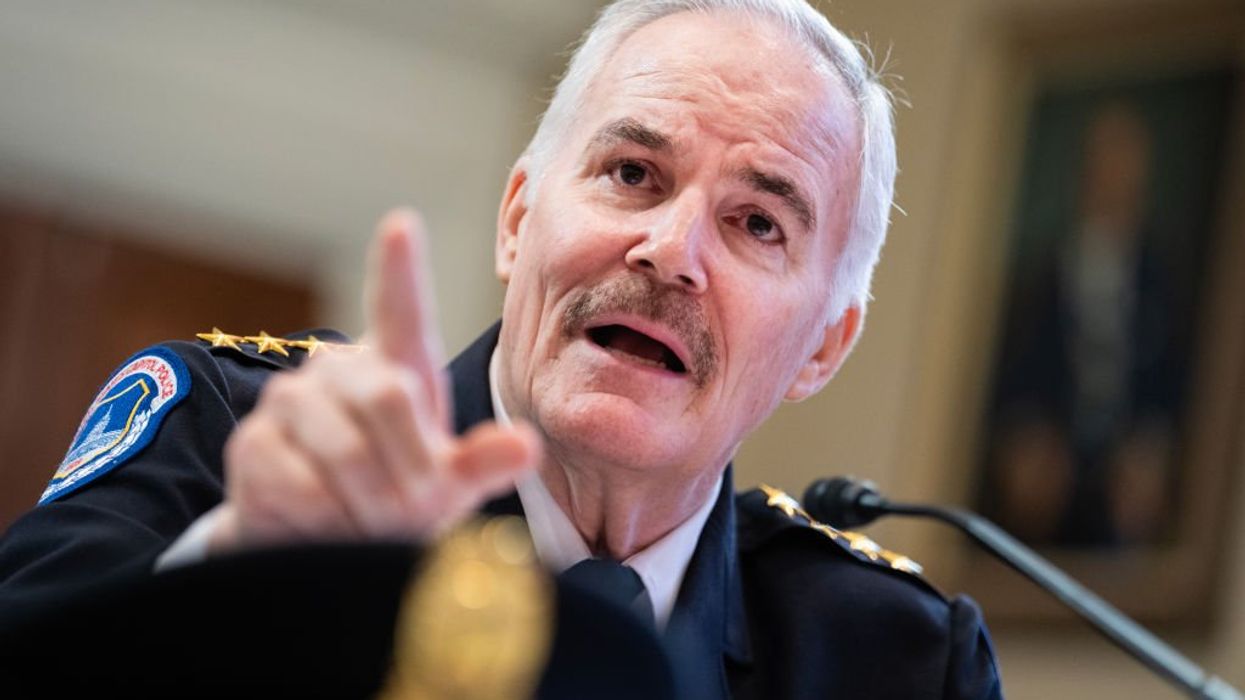
U.S. Capitol Police Chief J. Thomas Manger. Photo by Tom Williams/CQ Roll Call/Getty Images

Chief J. Thomas Manger claims settlement in $30 million wrongful-death suit is 'insulting' to officers who protected the Capitol.
Retiring U.S. Capitol Police Chief J. Thomas Manger took some parting shots at the late Ashli Babbitt on his way out the door, claiming in a May 2 internal memo that she “attacked the U.S. Capitol” and ignored police orders to stay out of the Speaker’s Lobby hallway where she was shot to death by Lt. Michael Byrd.
The two-page letter was read at all roll calls, posted on bulletin boards, and distributed by email. It expresses Manger’s disdain for the U.S. Department of Justice agreeing to settle the Babbitt family’s $30 million wrongful-death lawsuit filed against the federal government on Jan. 5, 2024.
Attorneys for Judicial Watch Inc. and the DOJ told a federal judge on May 2 they had reached a “settlement in principle” that should be finalized within weeks. No financial terms were disclosed.
Judicial Watch president Tom Fitton said the settlement is “going to be historic!” Judicial Watch represents Aaron Babbitt and his late wife’s estate in the lawsuit against the federal government.
A status report that Judicial Watch and the DOJ filed with U.S. District Judge Ana Reyes on May 6 did not include an update on the expected timing to finalize the settlement.
It did, however, propose that Babbitt’s former attorney, Terrell N. Roberts III, enter into fee arbitration with the Attorney Client Arbitration Board of the District of Columbia Bar. Roberts opposes that solution, the court filing said. Roberts’ attempts to secure a restraining order and a 25% lien on the final settlement were rebuffed by Judge Reyes. Roberts withdrew from the Babbitt case in late February 2022.
Manger’s letter makes several questionable contentions, including that Babbitt ignored orders by police to stay out of the Speaker’s Lobby.
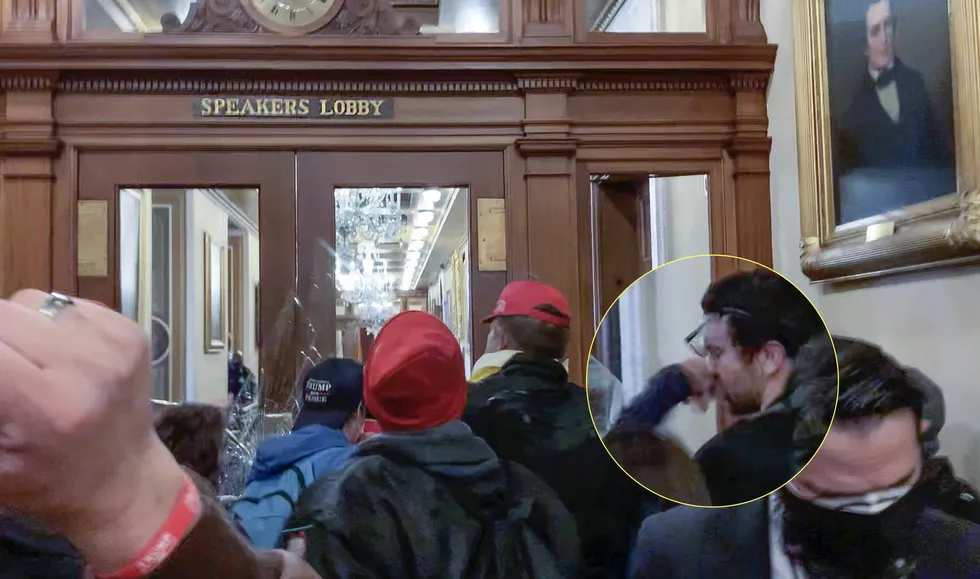
According to video shot by journalist Tayler Hansen, he and Babbitt freely walked into the hallway outside the Speaker’s Lobby at 2:36 p.m. On the way, they passed Jason Gandolph, a plainclothes House Sergeant at Arms officer. Hansen greeted him and said, “Stay safe.” Gandolph was walking and looking at his phone at the time.
Three U.S. Capitol Police officers were standing at the end of the hall outside the Speaker’s Lobby: Officer Kyle Yetter, Sgt. Timothy Lively, and Officer Christopher Lanciano. Hansen offered the officers a water bottle while Babbitt talked to the trio. They were the only ones in the hall with Babbitt and Hansen until other protesters began filling the space a short time later.
'We’ve got to start thinking about getting the people out.'
Gandolph told investigators that Babbitt helped to smash the glass in the doors and windows of the Speaker’s Lobby entrance. Video from the hallway shows, however, that Babbitt did not touch the doors or the glass, but she did shout at the officers to “call f**king help!”
“In 2021 the DOJ said there was no evidence to show law enforcement broke the law, yet now the DOJ is agreeing to pay a settlement,” Manger wrote.
A 14-page DOJ memo on the killing of Babbitt by then-Lt. Byrd, now a captain, was released in June 2022 by Judicial Watch as part of a Freedom of Information Act lawsuit.
The memo said there was “insufficient evidence to prove beyond a reasonable doubt that Lt. Byrd violated Ms. [Babbitt’s] civil rights by willfully using more force than was reasonably necessary, or was not acting in self-defense or the defense of others.”
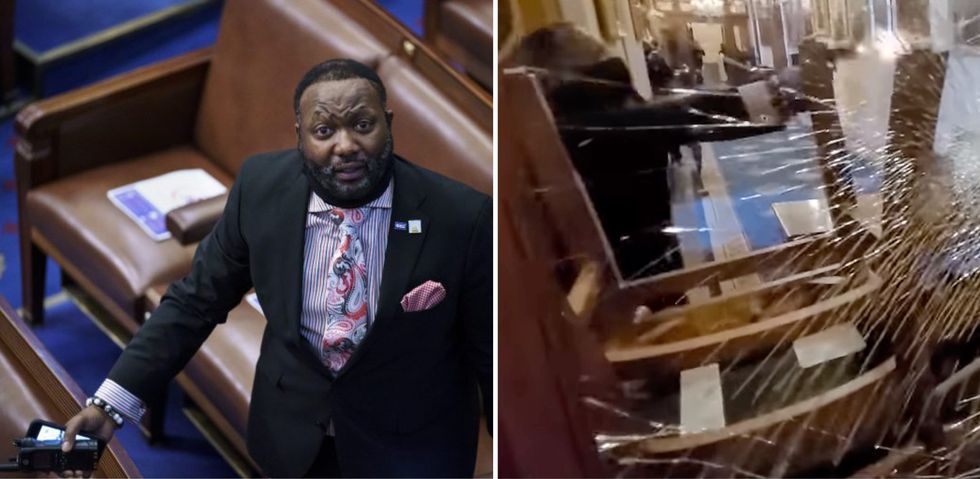
The DOJ memo has been criticized because it cited the wrong legal standard for determining whether police use of lethal force is justified. The “gold standard” is the 1989 U.S. Supreme Court decision in Graham v. Connor. The High Court said police use of force should be judged on the Fourth Amendment’s “objective reasonableness” standard without regard for the officer’s subjective state of mind.
“An officer’s evil intentions will not make a Fourth Amendment violation out of an objectively reasonable use of force; nor will an officer’s good intentions make an objectively unreasonable use of force constitutional,” the court said.
Even if the force Byrd used in killing Babbitt was unreasonable, “the government must show that an officer acted willfully, that is, with the specific intent to deprive the victim of a constitutional right,” the DOJ report said. In this context, “willfully” means that an act “was done voluntarily and intentionally, and with the specific intent to do something the law forbids; that is with a bad purpose either to disobey or disregard the law.”
'I asked for permission to evacuate. I heard no response.'
Stanley Kephart, a police use-of-force expert who has testified in court cases more than 350 times, said use of the term “willfully” is from a 1985 U.S. Court of Appeals case from the Fifth Circuit, United States v. Garza. He said it should not be applied to Byrd’s killing of Babbitt.
“The highest culpable mental state in committing a crime is ‘knowingly’ and Captain Byrd did just that,” Kephart said. “Willingly does not apply.”
Byrd did not write any reports on the shooting and refused to make a statement to internal affairs investigators. His only public statement on the shooting was made in a televised August 2021 interview with NBC anchor Lester Holt. Byrd said he feared for his life at the time he fired his service weapon. He said, however, he could not tell if the person climbing into the broken window was armed or even what sex the person was.
Kephart said he believes the Biden DOJ had a pre-ordained conclusion to the shooting probe. He called the DOJ report a “total miscarriage of justice.”
“The glaring thing about it, they picked the Garza decision, which was an aged decision. Graham v. Connor is the newest Supreme Court finding and that’s why it is the gold standard,” Kephart said. “For them to go back in time and pick an aged decision that was friendly to them is a clear indication of what they were attempting to do.”
Video from the hallway where violence broke out shows Babbitt tried to stop the rioting and shouted at officers to call for backup. Just before she climbed into the broken side window and was shot, she punched rioter Zachary J. Alam in the nose and knocked off his glasses. Alam had just used a black riot helmet to smash the glass out of the side window. Had Alam climbed into the broken window before Babbitt punched him, he most likely would have been shot.
“While illegally inside the building, she disregarded the orders of police to stay out of the Speaker’s Lobby and instead climbed through a broken window, which had just been smashed by a fellow rioter, in her attempt to access members of Congress who were being evacuated from the Capitol,” Manger wrote.
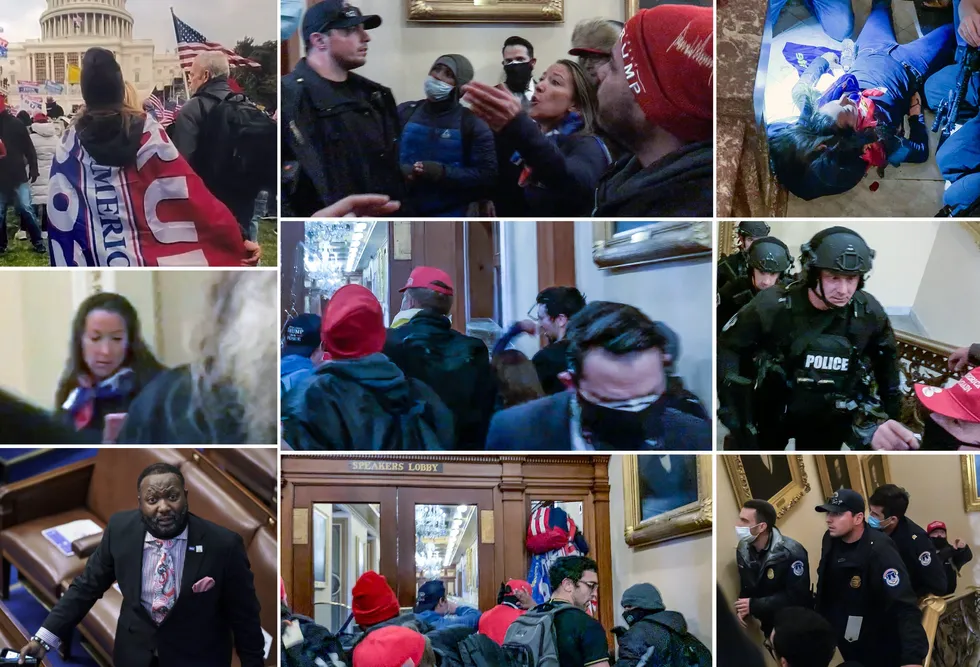
Byrd told Holt that he repeatedly screamed at the rioters to “get back.” Byrd was wearing a black COVID mask at the time. Other officers in the Speaker’s Lobby gave conflicting reports on whether commands were shouted to those outside the entrance.
Witnesses along the outside of the lobby entrance said they did not hear warnings or other statements from inside the Speaker’s Lobby. The crowd, which had grown to at least 55-60 people, made considerable noise. The three USCP officers posted at the door said they did not hear any commands from inside the Speaker’s Lobby. Nor were any commands heard on videos filmed in the hallway.
Aaron Babbitt said his wife, 35, who was a military policewoman in the U.S. Air Force and Air National Guard, would not have continued through the window if she had seen or heard Lt. Byrd.
Video showed the members of Congress were going downstairs toward the subway when Hansen and Babbitt first walked into the hallway outside the Speaker’s Lobby. A few members remained in the House Chamber to help guard the main House entrance, but the evacuation was otherwise complete by the time Babbitt jumped up into the window.
Manger said the lawsuit settlement “is insulting to every officer who protected the Capitol on January 6, 2021, and those who feared for their life on that dark day.”
One former Capitol Police officer went public with his opposition to Manger’s memo. Former Lt. Tarik K. Johnson, who first posted Manger’s letter May 5 on X, called the document “partisan.”
“How should he (Manger) be allowed to take a partisan position from the chair of a police chief when some could easily articulate his behavior as an abuse of power as his rant was put on USCP letterhead and distributed,” Johnson said.
In March, Manger announced he was retiring after nearly four years on the job. His announced last day was May 2, but a Capitol Police source told Blaze News that Manger was still on duty on May 6.
“How do we tolerate Manger criticizing the current administration in a civil matter without questioning his judgement and ability to lead a police agency that has a requirement to remain neutral and protect all members of the congressional community and visitors to the Capitol complex,” Johnson wrote, “not just those who share his political views.”
Johnson was suspended by Capitol Police for nearly 18 months after Jan. 6, ostensibly because he wore a red MAGA cap while he and and two Oath Keepers evacuated 16 police officers from inside the Capitol’s Columbus Doors. Johnson has said the cap made the crowds more receptive and helped him move up and down the east steps unmolested. He said the cap was like having a helmet for protection.
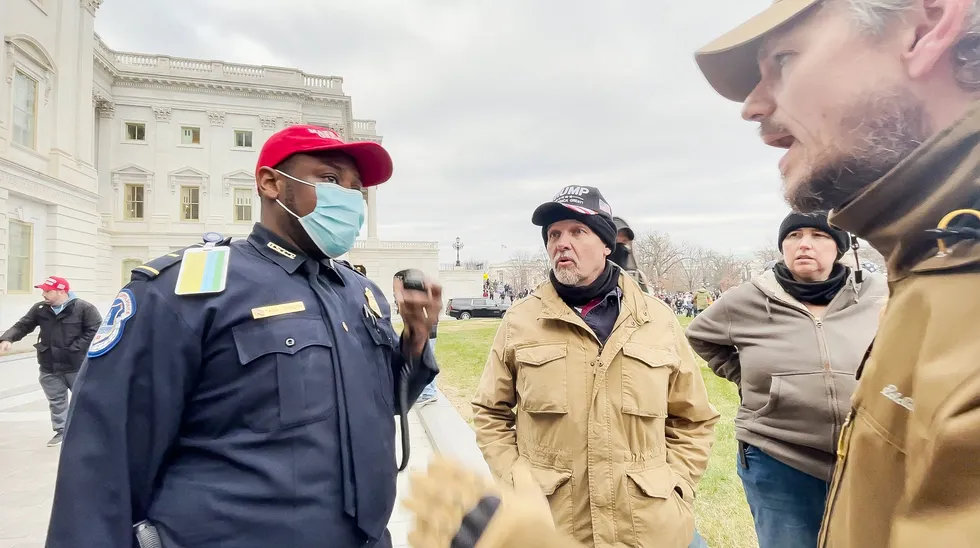
The suspension that Johnson said made him a virtual prisoner in his own home was really meted out because he ordered the evacuation of the U.S. Senate on Jan. 6 after the USCP Command Center failed to answer repeated radio transmissions seeking authorization, he said. Video shows just as the last senators hustled down the stairs, a raucous crowd was moving toward the Senate entrance from an adjacent hallway.
Johnson then headed toward the House and ordered members to evacuate the building. He gave Sgt. Nelson Vargas instructions over the radio on which door and stairway to use to reach the Capitol Subway System. It isn’t known why Byrd did not evacuate the House after rioters smashed the Senate Wing Door windows at 2:12 p.m. and crowds poured into the building. Byrd was the Capitol Police commander for the House and Senate on Jan. 6.
“There was no response from anybody at the Command Center,” Johnson said in a January 2023 interview. “I say even before I initiated evacuation, I say specifically, ‘We’ve got to start thinking about getting the people out before we don’t have a chance to.’ I heard no response. Then I asked for permission to evacuate. I heard no response.”
In addition to Johnson’s pleas for help, the Capitol Police dispatcher repeatedly asked for authorization for the evacuation. He was met with radio silence.
Johnson said if the evacuation of Congress had started when he first asked Assistant Chief Yogananda Pittman and the Command Center for help, Byrd wouldn’t have been near the Speaker’s Lobby entrance, and the House chamber would have been empty if the crowd had breached the barricaded doors.
“I made the evacuation order at approximately 2:28 for the Senate, and then I did it maybe six to eight minutes later for the House,” Johnson said.
Manger said his department and the Metropolitan Police Department did a “comprehensive review of all the available evidence” in the shooting.
Shortly after shooting Babbitt at 2:44 p.m. on Jan. 6, Byrd made a false broadcast on Capitol Police radio claiming that he was taking gunfire and was preparing to return fire. The false assertion was never corrected on the air, leaving SWAT officers streaming into the Capitol to wonder if the scene was secure or if a shooter was on the loose in the Capitol. Neither the DOJ report nor the MPD shooting investigation report made reference to Byrd’s radio transmission.
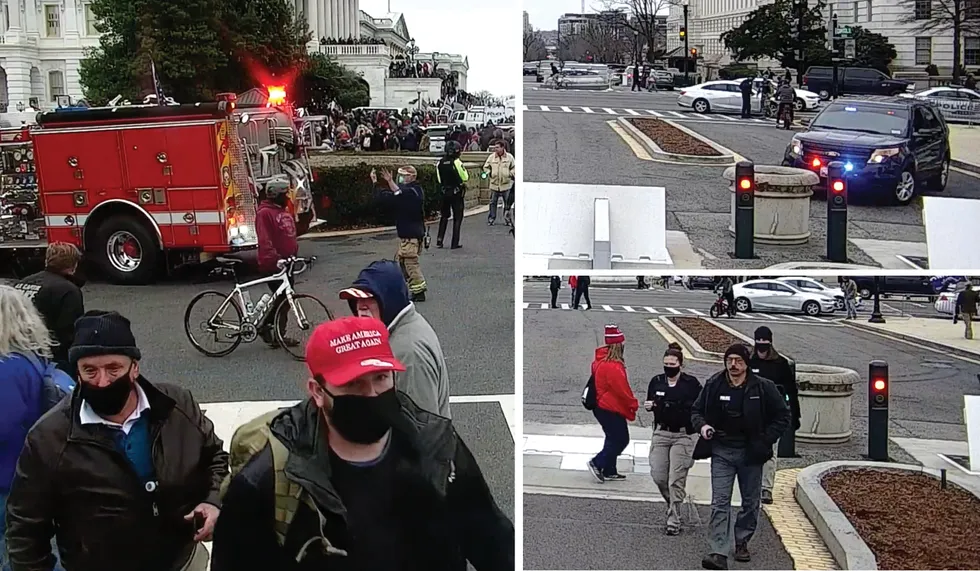
Police did not attempt to detain any of the more than 50 people in the Speaker’s Lobby hallway to take witness statements. As far as is publicly known, none of them was detained for questioning about the shooting, and none of their witness accounts appeared in the MPD or DOJ shooting investigation reports.
Two men, nicknamed “Frick and Frack” by a YouTube personality in 2021, stood behind the police line down the stairs from the lobby entrance as four Capitol Police SWAT officers came up from the first floor.
After protesters and rioters were forced to exit, Frick and Frack approached USCP Deputy Chief Eric Waldow in the hallway and volunteered to be witnesses. As a 2024 Blaze News investigation showed, the men were escorted from the building by Capitol Police K-9 technician Bruce Acheson and taken to meet with Capitol Police detectives in an unmarked squad car at the edge of Capitol grounds.
Frack gave police a short video clip taken in the Speaker’s Lobby hallway at the time of the shooting, but was apparently allowed to leave without providing all of the extensive video he shot on the Capitol west front, inside the building, and from the front rows of the Speaker’s Lobby hallway during the melee. The man’s name was redacted in the MPD shooting report. Some brief information on him was included in an MPD investigation memo.
Video showed Frick and Frack set up makeshift ladders out of police barricades to allow protesters to more easily climb onto the balustrade of the Northwest Steps and proceed into the Capitol. They have not been publicly identified and were never arrested or charged.
Kephart said the 2021 DOJ report should have delved more into Byrd’s service and discipline record. He urged that Byrd’s shooting investigation be reopened by the Trump DOJ.
The DOJ report includes nearly a dozen factual errors, some of which were repeated in the Manger letter.
In November 2024, U.S. Rep. Barry Loudermilk (R-Ga.), chairman of the Committee on House Administration Subcommittee on Oversight, sent Manger a letter outlining Byrd’s “significant” history of discipline cases.
In one 2004 incident, Byrd was found by the Office of Professional Responsibility to have fired his Capitol Police service weapon into the rear of a van that was fleeing his Maryland neighborhood. His neighbor was in the line of fire, Loudermilk said. Byrd told investigators he shot into the windshield as the van drove directly at him.
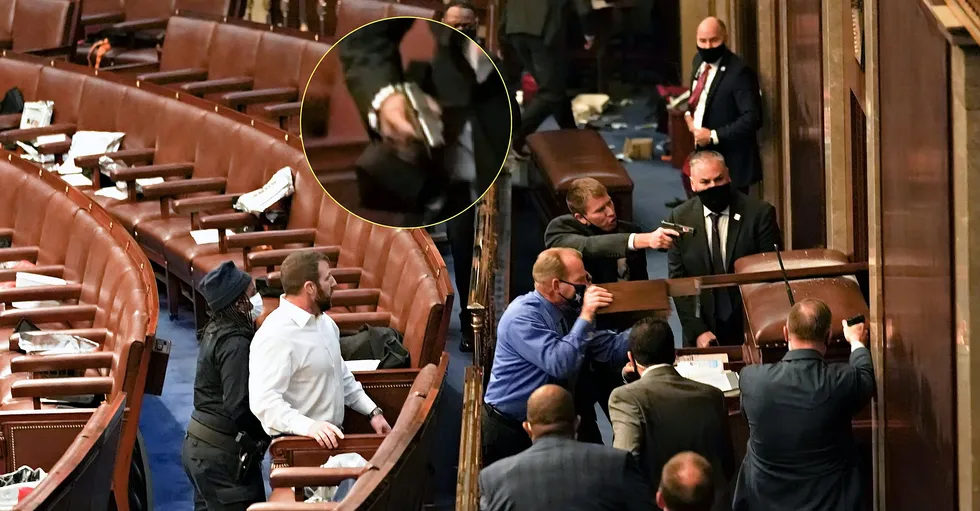
The OPR investigation found Byrd violated the USCP weapons and use-of-force policies by firing his gun in a “careless and imprudent manner.” Byrd appealed the finding to the Disciplinary Review Board, which overturned the OPR findings, according to Loudermilk.
In another discipline case revealed in a Blaze News exclusive, Byrd was recommended for termination in 2001 for abandoning his post in House Speaker Denny Hastert’s office for a card game in a nearby cloakroom, then lying about it to Internal Affairs Division investigators.
Loudermilk’s Nov. 20 letter also detailed the favorable treatment Byrd has received by USCP since Jan. 6, including $36,000 in unrestricted retention funds, $21,000 in security upgrades at his Prince George’s County, Md., home, and a GoFundMe campaign that raised $164,206 for Byrd.
Capitol Police paid to house Byrd at the Joint Base Andrews military facility from July 2021 until late January 2022 at a cost of more than $35,000, according to records obtained by Judicial Watch Inc.
Capitol Police general counsel Thomas A. “Tad” DiBiase met with Jamie Fleet, staff director for then-House Speaker Nancy Pelosi (D-Calif.), to discuss options to help Byrd, according to email uncovered by congressional investigators, Loudermilk said. Pelosi had earlier said she wanted Byrd “taken care of,” according to a Blaze News source who directly witnessed the statement during a meeting.
Loudermilk gave Manger a long list of questions and document requests at the close of his letter. The deadline was Dec. 4, 2024. A congressional source said Manger never replied to Loudermilk’s letter. The 118th Congress ended on Jan. 3, 2025. Five months after the start of the 119th Congress, the House has not yet established a successor committee or subcommittee to investigate Jan. 6.
Like Blaze News? Bypass the censors, sign up for our newsletters, and get stories like this direct to your inbox. Sign up here!